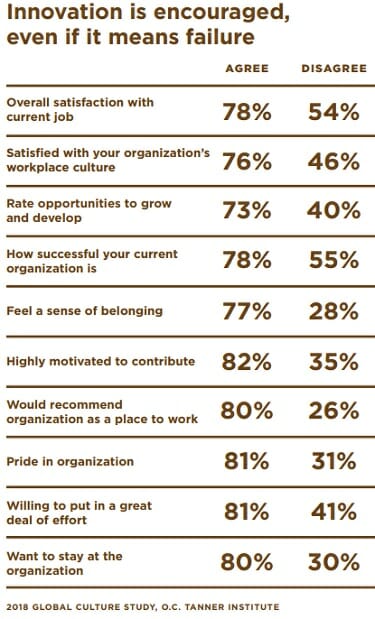One of the greatest players to step up to the plate, Babe Ruth revolutionized baseball by hitting 714 home runs while compiling a lifetime batting average of .342 — both among the best numbers of all time. But he was also known as the King of Strikeouts when he played — demonstrating that greatness and innovation can’t be accomplished without trial and error. And failure.
Companies need innovation more than ever to compete, but creating something new means taking chances. Like Babe Ruth’s 1,330 strikeouts, not all of those chances will pan out. But that’s a good thing: if you don’t have some failure, you’re not pushing hard enough toward innovation. The trick is to make your failure productive and to create a safe space for employees to fail without fearing repercussions.
The benefits of failure
It’s one thing to talk about the conceptual need for failure and failing safely, but it’s another to quantify what those benefits are. We wanted to know exactly what benefits it provided, so we included it in our research for the 2018 O.C. Tanner Global Culture Report, which surveyed more than 15,000 workers across a dozen countries.
According to the results, when failure is an accepted part of the innovation process, companies see 60% more great work than organizations that don’t have that facet within their culture. Employees within those safe-failure companies are also 166% more likely to feel their work represents significant innovation when they’re allowed to fail, which translates to a 37% increase in employee output. And it affects the bottom line, too — there is a 133% chance that a company’s revenue has increased in organizations with “safe failure.”
Smart failure
The benefits of letting employees feel they can stumble on the climb to success are strong, but not all failure is created equal. The kind of failure that propels organizations to innovation and greatness is productive failure, but it’s not a carte blanche for screwing up. When improperly directed, failure can be just that: failure. You still want it to propel you to success — you want “smart” failure.
One of the best ways to accomplish that is to really understand the problem you’re trying to solve. Having a very specific goal can also spur new ideas you wouldn’t have with a blank canvas, especially if you revisit the issue throughout the process and adjust your course if needed. Narrowing the focus, too, helps to keep intact the things that are working within the company. Maintain and respect those systems and processes that are working within your organization, and understand what role they play — now and after your project is finished — to guide your product to success.
Telling employees they can fail is one thing, but communicating that they can truly do so without fear of repercussion is another thing altogether. Start by announcing the policy you’ll be using as your infrastructure for safe failure, and remember to emphasize it with consistent words and actions.
Celebrate failure’s lessons
One thing we do is to make sure to recognize productive failure in the same way as we do success. We use those recognitions as an opportunity to highlight where the error occurred, how the individual overcame it and what they learned from it. We begin each team meeting by recognizing great performances and then we self-report a failure we’ve had and what we learned from it. We created the “Messed Up, Fessed Up” initiative within our recognition platform so we can vote as a team which award the “mess up” deserves: an “Oops,” “Uh Oh,” or “Oh Snap!”
These practices normalize failure and help reinforce the idea that stumbles are necessary on the pathway to success. They also serve to improve our institutional knowledge related to what works and what doesn’t.
This holds true for projects that we opt to kill entirely. In making these tough calls, it’s important to acknowledge that the decision to stop doing something is almost as important as the decision to do it in the first place. We also try to keep those projects in mind for future efforts that might benefit from repurposing specific components. Just because something failed in one venture doesn’t mean it’s an entirely wasted effort. For example, we pulled the plug on a product because the deeper we went into it, the more we realized it wasn’t breaking the ground we expected compared to our other product offerings. Not long after, though, we realized it could function well instead as a component of a product in our Culture Cloud suite of tools.
Does this mean failure is easy? Of course not. But it is necessary for innovation, and should be viewed — and respected — as being as necessary to the process as the eventual success. While not all failure is created equal, doing it right can make it a valuable resource for your company and employees, too.
